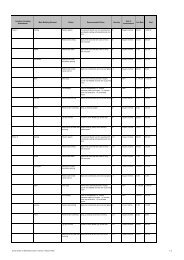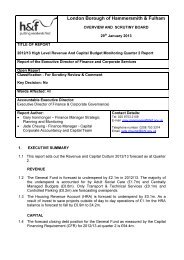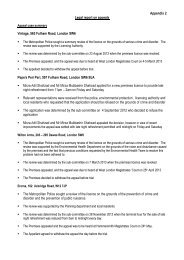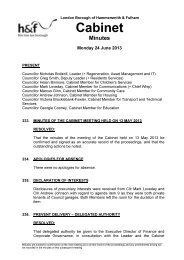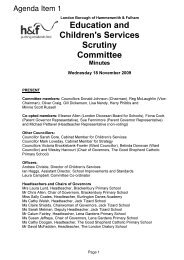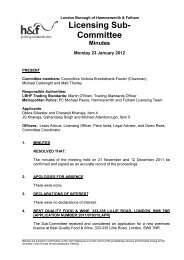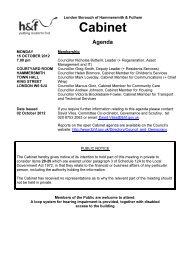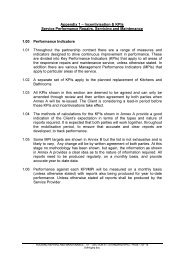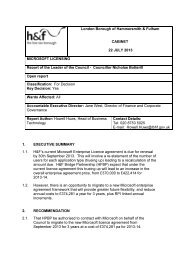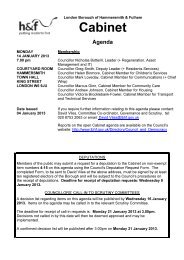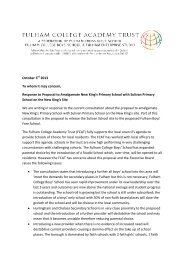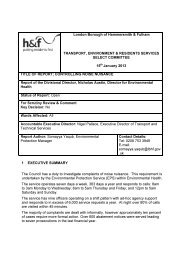Appendix 2 , item 46. PDF 26 KB
Appendix 2 , item 46. PDF 26 KB
Appendix 2 , item 46. PDF 26 KB
- No tags were found...
Create successful ePaper yourself
Turn your PDF publications into a flip-book with our unique Google optimized e-Paper software.
LBHF Participation Strategy <strong>Appendix</strong> 2Policy Background for the 14 – 19 team1. Raising the Participation Age (RPA).The Education and Skills Act 2008increases the minimum age at which young people in England can leavelearning, requiring them to continue in education or training until the end ofthe academic year in which they turn 17 from 2013/2014 or until their 18 thbirthday from the 2015/2016 academic year. Local authorities have existingresponsibilities to support young people into education or training, which areset out in the following duties:• Secure sufficient suitable education and training provision for all youngpeople aged 16-18 (inclusive) in their area. 1• Make available to young people below the age of 19 support that willencourage, enable or assist them to participate in education or training. 2• A local authority in England must ensure that its functions are (so far as theyare capable of being so exercised) exercised so as to promote the effectiveparticipation in education or training of persons belonging to its area to whomPart 1 of ESA 2008 applies with a view to ensuring that those persons fulfilthe duty to participate in education or training. 3(It is considered that other parts of the ESA duties are met by activity from the Tri-Borough Commissioning Team)Current Activity2. LBHF 14 – 19 Adviser has led on developing a bi-borough RPA strategy thatis underpinned by a bi-borough 14 – 19 strategy. The 14 – 19 strategy hasthree goals: Raising Attainment; Understanding the Cohort and EarlyIntervention Targeted Support for those who most need it. These goals areones that are held equally, but not severally by some other councildepartments, so it is important that the RPA work is viewed as one part of thesupport to young people, not the whole package. The RPA strategy thereforeis as an active document, that sets out certain activities to enable RPA to bemet and is flexible to change as and when other teams or areas of work aredeveloped.3. To meet this aspiration it has been written in collaboration with internal teams:School Improvement; Economic Development; Tri-Borough Commissioning;Youth Offending; Alternative Provision. In addition local providers fromschools, Further Education and private training providers also support theplan. This group of professionals meet on a termly basis (RPA ExecutiveBoard) to ensure activity is relevant, focussed and achieving aims. Activitiesfrom the plan fall into four broad categories and demonstrate how the 14 – 19team is working across other departments to meet the goals for full1 Sections 15ZA and 18A of the Education Act 1996 (as inserted by the Apprenticeships,Skills, Children and Learning Act 2009))2 Section 68 Education and Skills Act 20083 Section 10 ESA 2008
participation. Local Authority teams have recognised that some of theiractivity aligns with RPA so have agreed that some of their work strands areincluded in RPA goals.4. Work is owned by four task and finish groups, with oversight from the LBHFRPA Executive Board. All have membership from borough officers andeducation providers.• Building Futures: led by Economic DevelopmentPriority is to support appropriate training and skills programmes betweenproviders and employers that support transition for young people from 18upwards via developing a Skills Plan and leading on White City CommunityBudgets.• Data Transition and Tracking: led by 14 – 19 AdviserPriority is to develop a Risk of NEET Indicator that can be used by all teamsworking with young people. This will use retrospective NEET data to producea robust profile to support schools and supporting teams with preparing youngpeople for transition to the next stage of their education or training career.Pilot being developed in Spring Term 2013 with four providers with full roll outin 2013/2014 academic year. In LBHF this is led by the transitionscoordinator.• Diverse Pathways: led by TBAP Head of Commissioning and School SupportPriority is to ensure that all providers who work with vulnerable young peoplewho are accessing Alternative Provision are using an appropriate qualityframework that is robust. The group is monitoring Alternative Provision. It isalso acting as a network of providers (mainstream and AP) and supports inareas such as new duties under the revised Ofsted framework.• Post-16 Progression: led by 14 – 19 AdviserPriority is to plan and share activity leading to full participation withmainstream providers. One example is to jointly develop a pre-Apprenticeshippathway for young people in Year 12, which allows them the option toprogress to Level 3 programmes or to go to an Apprenticeship course. Thegoal of this is to reduce the likelihood of NEET churn at Year 12/135. The collaborative nature of the membership of these groups has led to deeperunderstanding between providers and borough officers of where their areas ofwork have shared goals and outcomes, without duplicating workunnecessarily.



